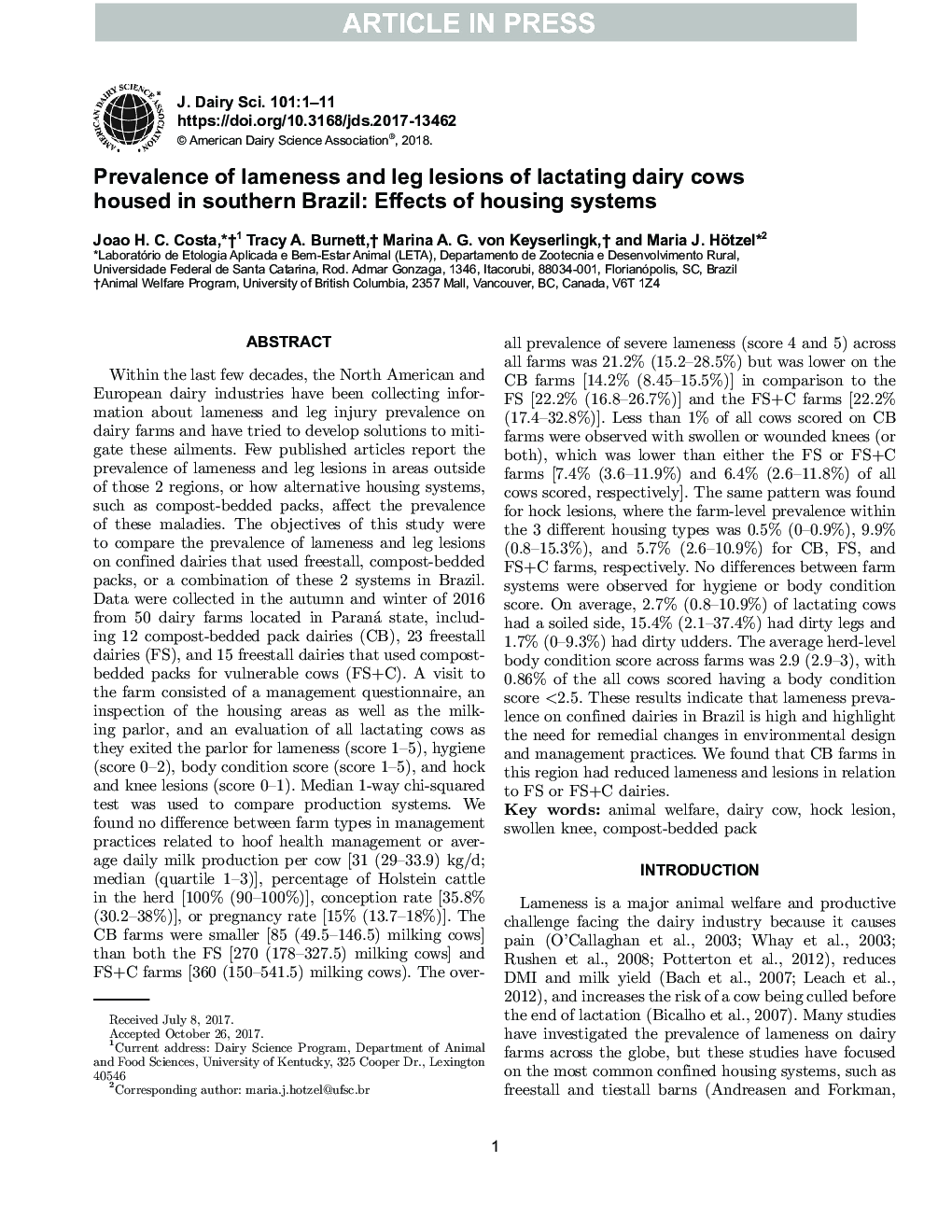| کد مقاله | کد نشریه | سال انتشار | مقاله انگلیسی | نسخه تمام متن |
|---|---|---|---|---|
| 8501432 | 1553842 | 2018 | 11 صفحه PDF | دانلود رایگان |
عنوان انگلیسی مقاله ISI
Prevalence of lameness and leg lesions of lactating dairy cows housed in southern Brazil: Effects of housing systems
ترجمه فارسی عنوان
شیوع لنگی و ضایعات پا در گاو های شیرده لاغر در جنوب برزیل: تأثیر سیستم های مسکن
دانلود مقاله + سفارش ترجمه
دانلود مقاله ISI انگلیسی
رایگان برای ایرانیان
کلمات کلیدی
رفاه حیوانات، گاو شیری، ضایعه ضعف زانو متورم بسته کمپوست
موضوعات مرتبط
علوم زیستی و بیوفناوری
علوم کشاورزی و بیولوژیک
علوم دامی و جانورشناسی
چکیده انگلیسی
Within the last few decades, the North American and European dairy industries have been collecting information about lameness and leg injury prevalence on dairy farms and have tried to develop solutions to mitigate these ailments. Few published articles report the prevalence of lameness and leg lesions in areas outside of those 2 regions, or how alternative housing systems, such as compost-bedded packs, affect the prevalence of these maladies. The objectives of this study were to compare the prevalence of lameness and leg lesions on confined dairies that used freestall, compost-bedded packs, or a combination of these 2 systems in Brazil. Data were collected in the autumn and winter of 2016 from 50 dairy farms located in Paraná state, including 12 compost-bedded pack dairies (CB), 23 freestall dairies (FS), and 15 freestall dairies that used compost-bedded packs for vulnerable cows (FS+C). A visit to the farm consisted of a management questionnaire, an inspection of the housing areas as well as the milking parlor, and an evaluation of all lactating cows as they exited the parlor for lameness (score 1-5), hygiene (score 0-2), body condition score (score 1-5), and hock and knee lesions (score 0-1). Median 1-way chi-squared test was used to compare production systems. We found no difference between farm types in management practices related to hoof health management or average daily milk production per cow [31 (29-33.9) kg/d; median (quartile 1-3)], percentage of Holstein cattle in the herd [100% (90-100%)], conception rate [35.8% (30.2-38%)], or pregnancy rate [15% (13.7-18%)]. The CB farms were smaller [85 (49.5-146.5) milking cows] than both the FS [270 (178-327.5) milking cows] and FS+C farms [360 (150-541.5) milking cows). The overall prevalence of severe lameness (score 4 and 5) across all farms was 21.2% (15.2-28.5%) but was lower on the CB farms [14.2% (8.45-15.5%)] in comparison to the FS [22.2% (16.8-26.7%)] and the FS+C farms [22.2% (17.4-32.8%)]. Less than 1% of all cows scored on CB farms were observed with swollen or wounded knees (or both), which was lower than either the FS or FS+C farms [7.4% (3.6-11.9%) and 6.4% (2.6-11.8%) of all cows scored, respectively]. The same pattern was found for hock lesions, where the farm-level prevalence within the 3 different housing types was 0.5% (0-0.9%), 9.9% (0.8-15.3%), and 5.7% (2.6-10.9%) for CB, FS, and FS+C farms, respectively. No differences between farm systems were observed for hygiene or body condition score. On average, 2.7% (0.8-10.9%) of lactating cows had a soiled side, 15.4% (2.1-37.4%) had dirty legs and 1.7% (0-9.3%) had dirty udders. The average herd-level body condition score across farms was 2.9 (2.9-3), with 0.86% of the all cows scored having a body condition score <2.5. These results indicate that lameness prevalence on confined dairies in Brazil is high and highlight the need for remedial changes in environmental design and management practices. We found that CB farms in this region had reduced lameness and lesions in relation to FS or FS+C dairies.
ناشر
Database: Elsevier - ScienceDirect (ساینس دایرکت)
Journal: Journal of Dairy Science - Volume 101, Issue 3, March 2018, Pages 2395-2405
Journal: Journal of Dairy Science - Volume 101, Issue 3, March 2018, Pages 2395-2405
نویسندگان
Joao H.C. Costa, Tracy A. Burnett, Marina A.G. von Keyserlingk, Maria J. Hötzel,
